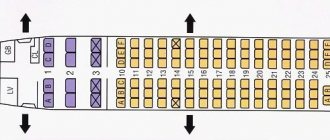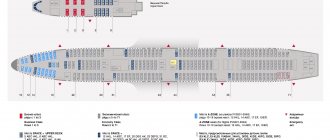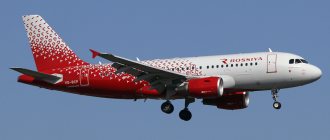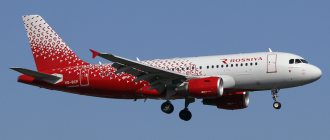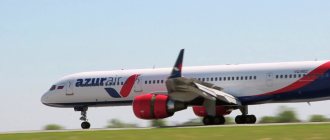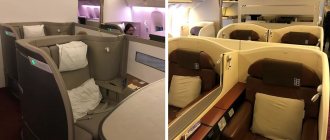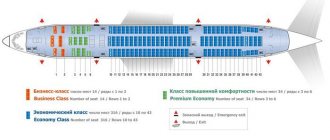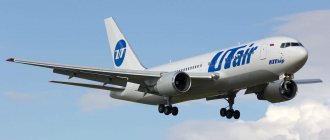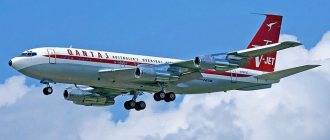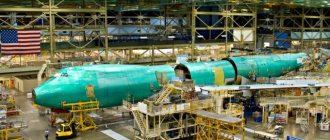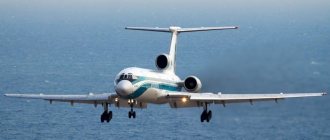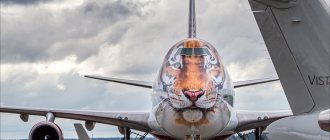Icelander Airlines Boeing 757. The plane has wingtips - early airliners did not have them. American Boeing aircraft can be seen at airports around the world. The most common of them is the 737, the most recognizable is the huge four-engine Jumbo Jet, but the Boeing 757 has not received such fame. True, one day he did come to the attention of journalists. This happened on September 11, 2001, when two such airliners were captured by terrorists, but such “advertising” could hardly benefit anyone. Meanwhile, the Boeing 757 is a very successful aircraft that has been “reproduced” into more than a thousand copies, many of which are still in operation. One of these Boeings belongs to the current US President, Donald Trump.
History of the development of the Boeing 757 passenger aircraft
In the mid-70s of the last century, the Boeing aircraft manufacturing corporation produced two types of narrow-body medium-haul airliners. These were Boeing 727 and 737 models. Both aircraft were not flawless, and customers had mixed feelings about them.
It should be borne in mind that the first generation of “737” was quite noisy and “voracious,” which was perceived extremely negatively against the backdrop of the consequences of the “oil crisis” of those years. The Boeing 727 was completely outdated: its design looked archaic.
Boeing 737 and 757 landing at the same time
Taking all this into account, the corporation's management decided to develop several new aircraft, tentatively designated Model 757, 767 and 777. An official announcement about this was published in early 1978. A few months later, in August, the concern received its first two orders from Eastern AirLines and British Airways, who wished to purchase a total of forty Boeing 757 units.
On February 19, 1982, the new airliner took off for the first time. The test program was successfully completed in December of the same year. The aircraft was certified first in the USA, and a month later - in England. During the same period of time, deliveries of the machine to customers began.
In 1984, the Boeing 757 with Pratt & Witney PW2037 engines was successfully certified. The first buyer of this modification was Delta Air Lines. Later, Boeing 757-200 airliners received more powerful engines - PW2040.
Construction of the aircraft continued until 2004, with the last few years producing a modification with an extended fuselage and increased cabin capacity. In total, 1050 cars were produced. From a commercial point of view, the aircraft has fully justified itself; it is still in use today.
Links
Jet - 367-80
- 707
- 720
- 717
- 727
- 737
- (Classic
- Next Generation)
- 747
- (
- 400
- Dreamlifter
- )
- 757
- 767
- 777
- 787
- Boeing Business Jet
In developing - 737 MAX
Promising Canceled - 2707
- 7J7
- New Large Airplane
- Sonic Cruiser
Description and technical characteristics
In its appearance, the Boeing 757 differs little from many other passenger airliners, standing out only for its size, primarily its length.
Model of Boeing 757 aircraft in scale 1:200
The aerodynamic design chosen for the Boeing 757 200 has now become traditional, however, in the 70s it was quite unusual. This is an aircraft with a single fin, low swept wing and stabilizers. The power plant includes two turbofan engines. They are located under the wings. The cross-section of the fuselage is the same as on the Boeing 727, but the length is 5.97 meters longer than that of the old airliner.
The widespread use of electronic equipment, which includes two on-board computers and an improved inertial reference system, has significantly simplified aircraft control and reduced fuel consumption. Compared to the early "seven hundred and thirty-seven", savings amounted to 45%. The flight engineer was excluded from the crew, the cabin was made double, with the exception of a few special modifications.
Photo gallery
- Uzbekistan.airways.757.arp.750pix.jpg
Boeing 757-200 aircraft.
- Turkmenistan.airlines.b757-200.ez-a014.arp.jpg
Boeing 757-200 Turkmen Airlines
- Alaport06.JPG
Almaty airport. Loading luggage into a Boeing 757 of Uzbekistan Airways.
- Condor B753 D-ABOF MUC.jpg
Boeing 757-300 at Munich Airport
- American 757 on final approach at St Maarten Airport.jpg
An American Airlines Boeing 757 lands at Princess Juliana Airport
- Air Astana plane taking off.jpg
Boeing 757 at Almaty airport
- UTair Boeing 757-200 Dvurekov.jpg
Boeing 757-200 of UTair airlines
- G-BYAW B757.jpg
Boeing 757-200 of Thomson Airways at Salzburg airport
Flight characteristics of the Boeing 757
The airliner was produced in three main modifications. Their operational and flight parameters are somewhat different:
| Boeing 757-200 | Boeing 757-200F | Boeing 757-300 | |
| Takeoff weight (maximum) | 115.9 tons | 115.9 tons | 123.6 tons |
| Empty weight | 58.44 tons | 52.43 tons | 64.34 tons |
| Width (fuselage cross section) | 3.7 m | 3.7 m | 3.7 m |
| Wingspan | 38.05 m | 38.05 m | 38.05 m |
| Aircraft length | 47.32 m | 47.32 m | 54.47 m |
| Ceiling (service) | 42,000 feet (i.e. 12,800 m) | 42,000 feet | 42,000 feet |
| Cruising speed | 850 km/h | 850 km/h | 850 km/h |
| Maximum range | 7,275 km | 5,834 km | 6,421 km |
| Fuel tank capacity | 43,490 liters | 42,680 liters | 43,400 liters |
| Number of passengers | From 200 to 239 | From 200 to 239 | From 243 to 295 |
Boeing 757-200F - transport version of the airliner
The initial take-off weight of the Boeing 757-200 aircraft was 99.8 tons, and subsequently this characteristic gradually increased, which is apparently explained by the initial underestimation of the potential carrying capacity of the machine, as well as an increase in engine power.
In Russia
Boeing 757 aircraft are included in the fleet of the following Russian airlines (2014):
- Azur Air (Katekavia) - 9 aircraft (capacity 238 passengers)[5]
- VIM-Avia - 8 aircraft (capacity up to 220 passengers)[6]
- I fly - 2 aircraft (capacity up to 221 passengers)[7],[8]
- Abakan-Avia (Royal Flight) - 5 aircraft (capacity from 224 to 235 passengers)[9]
- Yakutia (airline) - 2 aircraft (capacity 191 passengers) and 2 cargo Boeing 757-200F
Interior layout and seating arrangement
The internal layout of the Boeing 757 was carried out in accordance with the wishes of customers. Because of this, on two outwardly identical 757 200 airliners, the cabin layout can be completely different.
The original design featured a business class seated at the front of the aircraft with twenty-two seats. The seats were installed in a 2x2 pattern, in six rows on the left side of the aircraft and five on the right.
There are two toilets located directly behind the business class section (on either side of the central aisle). In the middle part of the liner there are 17 rows of seats, according to a 3x3 layout. Two additional seats, located on the starboard side, are placed slightly forward in relation to the others. Directly behind this section are two more toilets.
At the rear of the plane there are 9 more rows of economy class seats, and behind them is the galley. It is also worth mentioning the fifth toilet - it is located directly behind the cockpit, on the left side of the aircraft.
Boeing 757 200 cabin layout with business class and five toilets
In addition, there are several options for the layout of the cabin, which consists entirely of economy class seats:
- VQ-BOO. The number of toilets has been reduced to four: one near the cockpit and three between the central and aft compartments. The seats are installed in 41 rows, capacity - 235 people;
- VQ-BLM. There are also 4 toilets, but they are located differently - one on the left side between the bow and central compartments, one near the cockpit and two in front of the tail compartment. The seats are installed in 40 rows, capacity – 238 people;
- VQ-BTM (and also VQ-BTN). The number of toilets is 4. Two of them are located in the bow of the aircraft (one after the other on the left side), two more are in the very tail, on both sides of the aisle. 39 rows of seats can accommodate 230 passengers;
- VQ-BTR and VQ-BTB. Toilets are located between the central and tail sections, as well as in the bow of the aircraft, there are 4 of them in total. The seats are installed in 40 rows, the capacity is 235 people;
- VQ-BRL. There are only three toilets: two between the central and tail compartments, one near the pilot’s cabin. There are 40 rows of seats, the number of passengers is up to 238.
Diagram of the “single-class” cabin layout of the Boeing 757-200, variants VQ-BTB and VQ-BTR
The Boeing 757-300 had the greatest capacity. Relatively few such aircraft were produced.
Best places
With the exception of business class, the most comfortable seats in all layout options are those located in the front row of each compartment. This is where there is the most free space. It should be borne in mind that on the 1st and 11th rows in the VQ-BTB and VQ-BTR layout there are no windows, which not everyone likes. The 9th row in the VQ-BTN and VQ-BTM salons has the same feature - it is also the front one in its section (central), but it does not have “windows”.
Nice places
The main part of the seats in all variants of the Boeing 757 200er cabin layout provides approximately the same level of comfort. There is not as much space as in the front rows, but it is enough for a good rest during the flight.
Bad places
The seats located in the back rows of each section are considered inconvenient. Passengers sitting there cannot fully recline the seat back. In addition, such places are adjacent to the toilet, which creates additional noise and bustle. To find out in advance whether the proposed row is the last in the section, it is useful to take another look at the cabin layout immediately before purchasing a ticket.
Diagram of the “single-class” cabin layout of the Boeing 757-200, variants VQ-BTM and VQ-BTN
Each liner has its own name
In 2016, the company supported the initiative of Rostelecom, which proposed that Aeroflot give its aircraft names of cities. So all 69 ships received proper names. On the Boeing 737-800, city coats of arms are placed on the nose under the cockpit, and the names are on the sides. The left one has a Russian name, the right one has an English name.
Summary table of correspondence between names and tail numbers
| Board number | Proper name | Serves in the company |
| First group | ||
| VQ-BJX | Astrakhan | 16 years |
| VQ-BSS | Barnaul | 11 years |
| VP-BOD | Belgorod | new |
| VP-BOB | Bryansk | new |
| VP-BGR | Grozny | 1 year |
| VQ-BWJ | Kaliningrad | 2 years |
| VQ-BPX | Makhachkala | 10 years |
| VP-BGQ | Orenburg | 1 year |
| VP-BOA | Pyatigorsk | 1 year |
| VQ-BSR | Tyumen | 11 years |
| Second group | ||
| VP-BUS | Gatchina | 3 years |
| Third group | ||
| VQ-BUF | Ryazan | 11 years |
| VQ-BUE | Penza | 11 years |
| Fourth group | ||
| VQ-BVV | Kemerovo | 3 years |
| VQ-BVU | Krasnodar | 3 years |
Flight safety
Over all the years of operation, 10 Boeing-757 aircraft crashed as a result of various disasters. In six cases this resulted in significant loss of life. The most famous events were September 11, 2001, when terrorists hijacked two Boeing 757s operating on domestic American airlines. One of them crashed into the Pentagon building, and the second crashed to the ground in Pennsylvania. In this case, 233 people died, of which 108 were on board the airliners.
Another high-profile disaster was a collision over Lake Constance, when a Boeing 757 transport crashed into a Russian Tu-154 carrying 69 people, mostly children. The cause of this terrible disaster was a gross error by the dispatcher.
At the same time, the most “alarming” incidents involving the same aircraft are mentioned less frequently. Both of them occurred in 1996: on February 6, a Boeing 757 crashed into the waters of the Atlantic, killing all passengers and crew members (189 people in total), and on October 2, a similar aircraft crashed into the Pacific Ocean. All 70 people on board were killed.
The cause of both accidents was a malfunction of the aircraft commander's speed meter. The readings from this instrument did not match those displayed on the co-pilot's panel. As a result, the on-board electronics became confused, and the crews were unable to understand the situation. Both planes went into a tailspin and crashed. Later, those who serviced the planes on the ground were found guilty, but these cases showed that on-board equipment is too sensitive to external influences.
The crash site of a Boieng 757 that crashed into the Pentagon
Accidents and disasters
As of January 10, 2022, a total of 10 Boeing 757 aircraft have been lost as a result of accidents and serious accidents. There have also been 12 hijacking attempts, resulting in the deaths of 108 people. A total of 575 people died in these incidents.
| date | Board number | Disaster site | Victims | Short description |
| 02.10.1990 | B-2812 | Guangzhou | 82+46/122 | I was waiting for takeoff and collided with a Boeing 737 that crashed onto the runway. |
| 06.04.1993 | n.d. | Taipei | 0/200 | Attempted hijacking. |
| 25.07.1993 | n.d. | Djibouti | 0/134 | Was hijacked by two Ethiopian soldiers armed with a fake grenade. |
| 02.08.1993 | N508UA | Denver | 0/164 | Hard landing due to crew errors. |
| 23.01.1994 | n.d. | Rome | 0/43 | It was hijacked by an Ethiopian who was unhappy with the political situation in the country. |
| 25.04.1994 | n.d. | Sana | 0/148 | Was hijacked by an Ethiopian armed with a toy revolver. |
| 25.11.1994 | N413UP | Tulsa | 0/2 | Cargo flight. During landing, the tail part touched the runway. |
| 20.12.1995 | N651AA | Cali | 159/163 | Crashed in the mountains, the crew chose the wrong orientation point. |
| 06.02.1996 | TC-GEN | Atlantic Ocean | 189/189 | Fell from the train. The speed sensor was blocked by a sand wasp nest several days before the flight and was giving incorrect readings. |
| 02.10.1996 | N52AW | Pacific Ocean | 70/70 | Fell from the train. The sensors on the left plane of the wing were sealed with insulating tape, which they forgot to remove after washing the plane. |
| 10.03.1997 | B-27001 | Xiamen | 0/162 | He was hijacked by an invader who wanted to obtain political asylum in the PRC. |
| 24.12.1997 | PH-TKC | Amsterdam | 0/213 | During landing, it landed 3 kilometers after the runway and caught fire. |
| 01.01.1998 | G-WJAN | Puerto Plata | 0/228 | The tail hit the runway after landing. |
| 22.02.1999 | N682DA | Cincinnati | 0/132 | During takeoff, a flock of birds was sucked into the engines. |
| 14.09.1999 | G-BYAG | Girona | 1/245 | During a hard landing in a rainstorm, it damaged the landing gear, rolled off the runway and collapsed. |
| 27.07.2000 | n.d. | NY | 0/150 | Attempted hijacking. |
| 11.09.2001 | N644AA | Washington | 125+64/64 | Captured by terrorists. Crashed into the Pentagon building. |
| 11.09.2001 | N591UA | Shanksville | 44/44 | Captured by terrorists, flying to Washington. Crashed in a field after passengers fought terrorists. |
| 02.03.2002 | N589UA | Seattle | 0/89 | While preparing for takeoff, an anti-icing truck crashed into the plane. |
| 01.07.2002 | A9C-DHL | Lake Constance | 69+2/2 | Cargo flight. Collided in mid-air with a Tu-154 due to an air traffic controller error. |
| 17.11.2002 | 4X-EBS | Istanbul | 0/89 | Attempted hijacking. |
| 28.11.2002 | 4X-BAW | Mombasa | 0/271 | The terrorists fired two surface-to-air missiles at the plane, but they flew past. |
| 19.01.2003 | N550NW | NY | 0/1 | During repairs, an A319 crashed into it. |
| 02.02.2003 | n.d. | Fuzhou | 0/160 | Attempted hijacking. |
| 07.03.2008 | n.d. | Lanzhou | 0/n.d. | The passenger tried to set the plane on fire. |
| 07.03.2013 | N698DL | Atlanta | 0/148 | The tail part caught the runway during landing. |
| 13.12.2013 | N202UW | Amsterdam | 0/n.d. | The wings collided with a Boeing 737-800. |
| 15.09.2014 | N654A | Miami | 0/172 | During landing, it hit the runway with its tail, was damaged and written off. |
| 22.10.2014 | N67171 | Minneapolis | 0/190 | While taxiing to the runway, the wings collided with the E-170. |
| 26.02.2015 | C-GIAJ | Newfoundland and Labrador | 0/2 | Cargo flight. He barely avoided rolling off the ice-covered runway. |
| 10.04.2017 | G-LSAI | Alicante | 0/238 | The tail part hit the runway. |
| 17.08.2017 | VQ-BTN | Antalya | 0/n.d. | A few minutes after takeoff, due to technical problems, the pressure in the cabin dropped sharply. The pilot successfully returned the plane to the departure airport. |
| 09.11.2018 | N524AT | Georgetown | 1/126 | Rolled off the runway after an emergency return to the airport. |
| 28.11.2018 | N757AF | NY | 0/0 | The board of the US President. A taxiing Bombardier Global Express caught the wing of a stationary 757 with its tail. The plane was restored. |
Pros and cons of the Boeing 757
For its time, the Boeing 757 was a very advanced aircraft. In particular, it has the following advantages:
- Low fuel consumption. This advantage was most noticeable when compared with earlier models, but subsequently the Boeing 757 retained its reputation as an economical aircraft;
- High level of flight safety. Despite several accidents, in general the aircraft proved to be very reliable. The accident rate has decreased by almost ten times compared to the Boeing 727;
- Large interior capacity.
Among the shortcomings of the aircraft, one can note a somewhat strange approach to the internal layout. The interior layout of the Boeing 757 200 is unreasonably diverse. It is often asymmetrical, which creates unnecessary confusion when purchasing tickets. Places without portholes also raise questions, especially considering their overall advantageous location.
Another disadvantage, but from the point of view of airlines, is the uncertainty of the “niche” of this airliner. It, especially in the 757-300 version, is somewhat large for a medium-range aircraft. This is where occupancy problems arise. Perhaps it was for this reason that some carriers preferred to buy narrow-body Airbuses.
Boeing 757 owned by Donald Trump
Notes
- McMillin, Molly
[www.kansas.com/mld/kansas/9361132.htm Wichita's final 757 to take a bow].
Wichita Eagle
(August 10, 2004). Retrieved April 10, 2012. [web.archive.org/web/20050427170157/www.kansas.com/mld/kansas/9361132.htm Archived from the original on April 27, 2005]. - [www.boeing.com/news/releases/2004/q4/nr_041028g.html “Boeing Marks Completion of its 757 Commercial Airplane Program”]
- [aviation-safety.net/database/dblist.php?field=typecode&var=105%&cat=%1&sorteer=datekey&page=1 Aviation Safety Network > ASN Aviation Safety Database > ASN Aviation Safety Database results]
- [www.airdisaster.com/cgi-bin/view_details.cgi?date=09141999®=G-BYAG&airline=Britannia+Airways Accident Database: Accident Synopsis 09141999]
- [www.airfleets.net/flottecie/Azurair-active-b757.htm Register of AzurAir Boeing 757 aircraft]
- [www.airfleets.net/flottecie/VIM%20Airlines-active-b757.htm/ Register of Boeing 757 aircraft of VIM-Avia]
- [www.airfleets.net/flottecie/I-Fly-active-b757.htm/ Registry of Boeing 757 aircraft of I Fly airline]
- [www.iflyltd.ru/index.php/2011-06-22-11-44-26/2011-10-17-08-48-36/ Cabin diagram of the Boeing 757 airline Airline]
- [www.airfleets.net/flottecie/Royal%20Flight-active-b757.htm/ Registry of Royal Flight Boeing 757 aircraft]
- [iron-maiden.ru/Novosti/Novosti-ot-gruppy/Pervye-Fotografii-Ed-Force-One.html First Photos of Ed Force One]
- [saroavto2.blogspot.ru/2015/12/blog-post_2.html The first commercial flight arrived in Antarctica]
Main Boeing 757 models
There are four main modifications of the Boeing 757 airliner, of which only three were mass-produced.
Boeing 757-100
The initial design of the aircraft, which received an index of 100, was supposed to have a maximum capacity of 160 passengers. This plan was not realized most likely due to direct overlap with the Boeing 737. It would be wrong to build two aircraft at once for the same purpose and with the same characteristics.
Boeing 757-200
The main version of the airliner was designated 200. Its maximum capacity was increased to 240 people. Built with several types of engines: RB211-535, PW2037, PW2040. In total, at least 868 of these aircraft were produced.
Boeing 757-200F
This modification is a transport aircraft. In place of the passenger compartment there is a cargo compartment 33.27 meters long and 3.53 meters wide. The aircraft's payload reaches 36 tons. To accommodate cargo, both the main and two additional compartments are used, the dimensions of which are 13.09 by 1.38 meters. The maximum flight range is reduced compared to the passenger version.
Boeing 757-300
The latest modification of the aircraft is a passenger airliner capable of carrying up to 289 passengers. To achieve this, the length of the fuselage had to be increased to a record value for civil aviation - 54.47 meters. The interior of the aircraft has been significantly redesigned, which is modeled after the newer Boeing 777.
Boeing 757-300 is the longest aircraft in the history of civil aviation
Despite the fact that all the transformations were carried out in strict accordance with the wishes of the airlines, significant demand for this modification never arose.
As a result, it became the last for the Boeing 757 - the construction of aircraft of this model was completely stopped in 2004.
Primary activity
At the moment, the corporation is engaged in the design and manufacture of aviation equipment for civil needs and the transportation of passengers; in addition, military and space aviation equipment is being actively developed. This company is the main competitor of the world-famous Airbus company, which is also engaged in civil aircraft construction. In addition, it develops helicopters for various purposes and participates in government space programs.
The production of equipment is carried out simultaneously in 67 countries of our planet. And they sell their products to 145 countries. As for partners and suppliers, Boeing cooperates with more than 5.2 thousand companies from all over the world. At the beginning of 2001, a separate division was organized to monitor work in the corporation's branches. This department is developing a strategic plan for the further development of the company, which will allow it to beat competitors and achieve maximum profits.
| Everett, Washington, USA | Boeing plant in Everett |
| Seattle, USA | Boeing plant in Seattle |
| Saint Louis, USA | Boeing plant in St. Louis |
The Boeing Corporation has only one global competitor, which is the European Airbus Corporation. These companies occupy the same niche in the world market, since they offer almost similar products.
